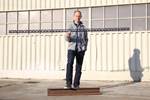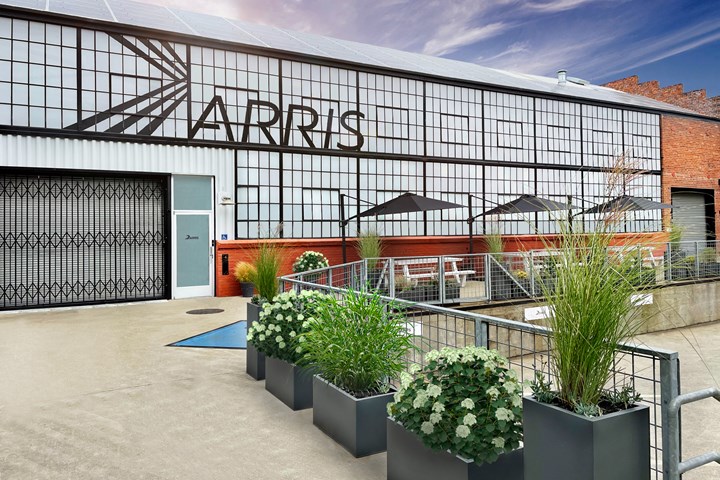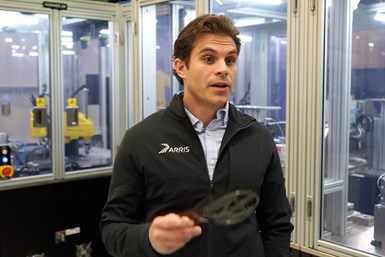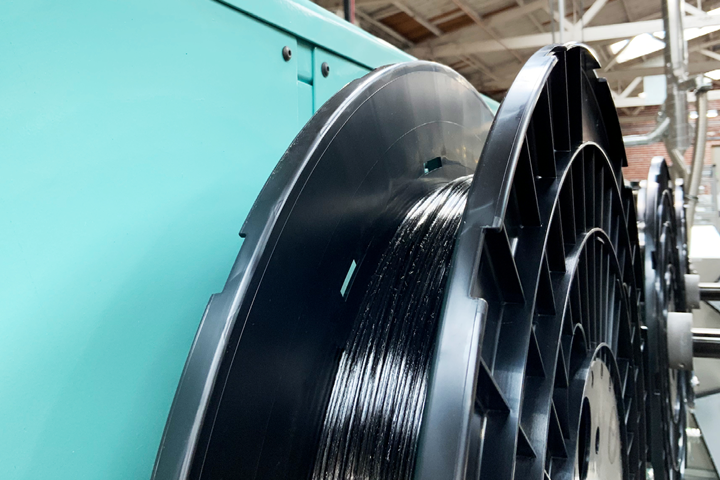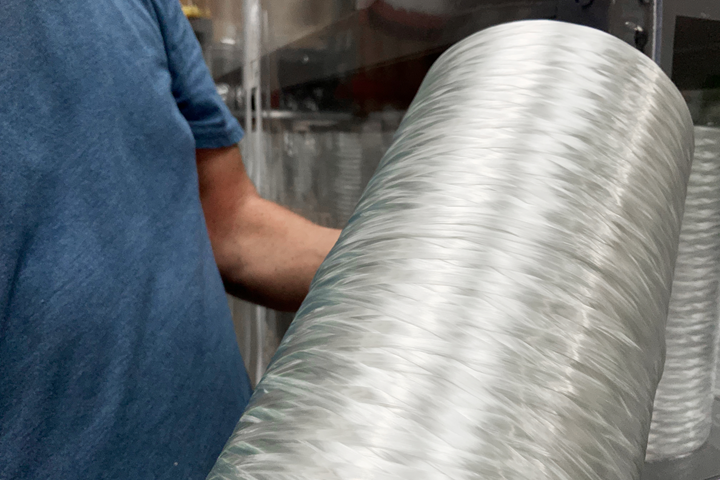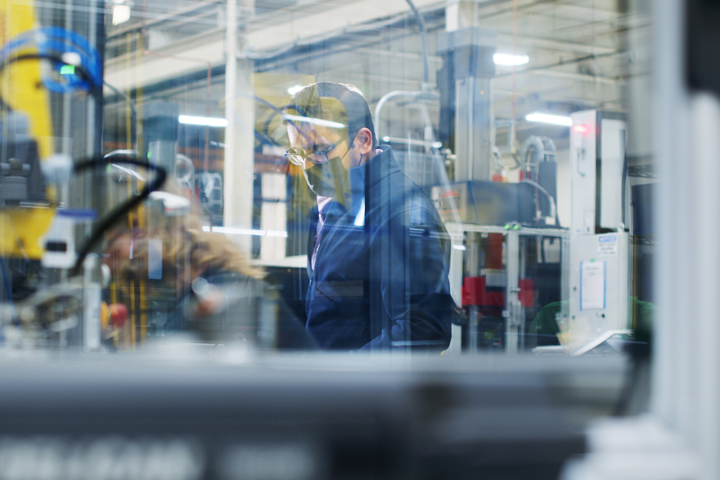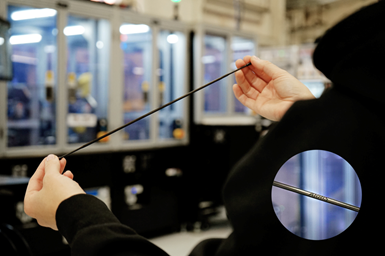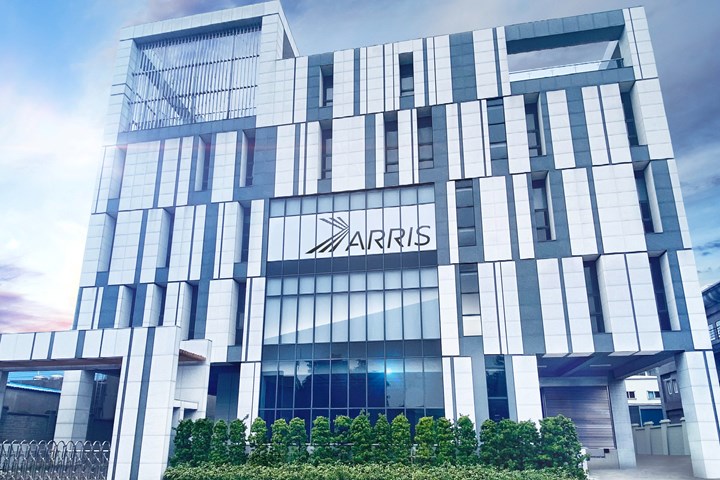Arris Composites operates two facilities. Its headquarters is here, in Berkeley, Calif., U.S. Its second facility is located in Taiwan. The company performs some manufacturing in Berkeley, but the facility primarily serves as an R&D and design and process development center. Photo Credit, all images: Arris Composites
One of the Holy Grails of composites manufacturing is a robust, consistent, automated fabrication process that makes possible the kinds of high-volume, high-quality applications that have, for much of the industry’s history, been out of reach. The advent of affordable, efficient robotic systems combined with manufacturing process and materials innovation is starting to put such applications within reach. Arris Composites (Berkeley, Calif., U.S.) is an example of a composites fabricator working in this realm.
Arris, true to its Bay Area roots, was started in a garage in 2017, founded primarily by Riley Reese, Ethan Escowitz and startup specialist Erick Davidson, with the support of Carl Bass, former CEO of Autodesk. The founders brought particularly strong experience in composites and additive manufacturing (AM), but were looking to mature and evolve AM in a way that could allow for fast and efficient integration of fiber reinforcement. This would, they theorized, open up applications and markets that the composites manufacturing industry had difficulty serving.
They developed and patented Additive Molding, which consists of automated preforming of thermoplastic prepregs followed by consolidation. The key to the process, however, is to combine fast and precise fiber orientation control with an unusual level of automation, thereby enabling high-rate, consistent fabrication of highly engineered discrete parts.
Riley Reese is a cofounder and CEO of Arris. Although the company has established a strong presence in the footwear market, he expects soon that the company will begin manufacture of composite housings for the consumer electronics market.
In a 2020 CW story about Arris, Escowitz describes the challenge that Additive Molding addresses as “scaling novel parts without the cost of traditional aligned fiber composites.” The technology, he asserts, creates structures in which “the entire volume of fiber is running along the mechanical loading pathways you desire and reinforcing where the properties are needed. We can align fibers in a way that no one else can at high production volumes.”
The founders conceived of a vision in which Arris would, one day, become one of the rare composites fabricators able to serve the demanding, high-volume world of electronics housing manufacturing. Getting to that point, however, would require Arris to prove its Additive Molding process in other applications first, which the company did, winning contracts for brackets, drone components and footwear.
Arris’ Additive Molding process uses thermoplastic prepreg tapes that are robotically placed in a mold to build a preform, and then compression molded. The company makes its own prepreg and works with carbon, glass and natural fibers. Shown here is a spool of carbon fiber-reinforced thermoplastic prepreg.
In the meantime, Arris gradually grew, moved through its funding rounds and migrated into larger facilities to accommodate the people and capital equipment its process requires. The heart of Arris is located in a large, open, sun-lit facility on the west side of Berkeley, just a stone’s throw from the San Francisco Bay. However, the majority of Arris’s footprint lies in Taiwan where the company has a manufacturing scaling production program and high-volume materials manufacturing. Arris has also brought on contract manufacturers to complement its Taiwan facility and provide further scale-up capacity.
Today, Reese serves as the company’s CEO and is the driving force behind the team of experts that have actualized the Arris promise to mass-produce high-performance composites.
U.S., Taiwan facilities, contract manufacturers
The Berkeley facility comprises two sections — office/work space on one side and manufacturing on the other. On entry, you immediately find yourself in a large, open shared space, with workstations and desks in rows, and cubicles sprinkled here and there. Plants are plentiful. Designers, engineers and administrative staff are at work here in what is clearly designed to be a collaborative environment.
The other half of the building, on the other side of the wall to the right of the work area, is where Additive Molding is done, and like the work area, it’s very open and contiguous. The first thing you see is a partitioned area dedicated to materials impregnation lines used by the R&D team to come up with new formulations and processes. Beyond this section, you enter the production floor with several manufacturing cells composed of glass-walled enclosures. Inside each enclosure is a serpentine conveyor weaving through a series of small, multi-axis FANUC (Rochester Hills, Mich., U.S.) robots. Traveling on these conveyors are preform molds, and at each robot, thermoplastic prepregs are placed in the mold in a specific location and orientation. This is step one in the Additive Molding process.
By the time the mold reaches the end of the line, the preform is fully built up and ready for transfer to compression molding. (Most of the parts Arris fabricates are relatively small — ranging from running shoe plates to bicycle parts to drone components, and all of the equipment here is scaled for such applications.)
Arris is agnostic regarding fiber use, but its Additive Molding process depends entirely on use of thermoplastic resin systems. Shown here is a roll of glass fiber, before prepregging and slitting.
Each cell is unique, designed to produce a specific part for a specific application, thus the configuration of conveyor and robots varies, but in general, each cell is about the same size — approximately 20 feet long and 10 feet wide. Reese says the complexity of the cells varies, depending on the application. Further, he notes that the newer cells are located in its production facilities in Asia. These are more “evolved” than older cells at its facility in Berkeley and have a much larger footprint and higher throughput.
Operators on the floor monitor each cell, but they are only needed to move parts into and out of the cell. Then there are standalone presses used for low-volume proof-of-concept production. This makes up the majority of the manufacturing floor at their Berkeley site. Operators work at each press, building the first articles for new product introduction.
Cycle time of a given Additive Molding cell varies depending on the size and complexity of the part, but the use of automation to build the preforms, and the ability to gang multiple molds into a press enables Arris to produce a part a minute, and sometimes faster than that. Further, the consistency of the automation, combined with good process control, provides unusually consistent part quality, says Reese.
At the end of the manufacturing area, past the cells and presses, is an alcove separated from the main floor. This contains a collection of CNC machines, mainly from Doosan (Seoul, South Korea) and Mitsubishi Electric (Tokyo, Japan). Arris builds many of its own molds and tools and has wire electrical discharge machining (EDM), sinker EDM and three- and five-axis machining capabilities to provide this service.
As we walk back around, we pass a climate-controlled quality and testing room. Inside is an Instron (Norwood, Mass., U.S.) machine, a large-scale drop impact tester, a Zeiss (Thornwood, N.Y., U.S.) CMM, OMM and other inspection equipment.
Reese notes that Arris’ manufacturing capability in Berkeley is designed to meet one of two manufacturing strategies the company has established. The first is to provide rate production services for aerospace and defense applications — the kind of work that typically cannot leave the United States. The second is to provide process engineering R&D to establish fabrication parameters and standards for specific parts and applications. These parameters, once set, are then transferred to Arris’ second facility in Taiwan or to one of its contract manufacturing (CM) partners, where most of its high-rate production is performed.
Preforms for the Additive Molding process are built up using multiaxis FANUC robots that operate inside enclosed manufacturing cells like this one. Molds are conveyed past the robots, which place prepreg tapes into the mold cavity. The Additive Molding process depends on automation for consistency, quality and high-rate fabrication.
Manufacturing capability in Asia, says Reese, is a significant part of the company’s strategy, particularly as it eyes the larger consumer electronics space. In addition to Arris’ wholly owned facility in Taiwan, the company has also outsourced some footwear production to its Malaysian CM. And when the company enters high volume production in the electronics market, Reese says it has another CM in Asia already setup and ready to go.
Materials, sustainability, applications
Arris is agnostic as to the types and varieties of fibers it uses in its Additive Molding process. Carbon, glass and natural fibers are all viable. Resin matrices, however, are confined to thermoplastics, and to date, says Reese, the company has primarily worked with polypropylene (PP), polyamide (PA), polycarbonate (PC), polyphenylene sulfide (PPS), thermoplastic polyurethane (TPU) and polyetheretherketone (PEEK).
Given this diverse mix of fibers and resins, and the need for high-quality prepreg tapes in the Additive Molding process, Arris does all of its own prepreg manufacturing. This is performed at the company’s Taiwan facility, where much of the material is consumed. The rest is shipped to the contract manufacturer in Malaysia or to Berkeley.
Reese says the decision to use thermoplastics is driven primarily by the Additive Molding process, which is tuned to heating and forming thermoplastic prepregs. He also notes that thermoplastics offer sustainability and performance advantages — ease of recycling, toughness, durability and strength/stiffness — that are attractive to many customers.
Glass fiber-reinforced thermoplastics are also a good fit for consumer electronics applications where radio frequency (RF) transparency, impact resistance and decarbonization are particularly important.
“In the consumer electronics space, we’re focusing mostly on housings for tablets, smartphones, wearables and VR/AR parts,” Reese says. “For example, we demonstrated a housing for an industry-leading mobile technologies company that replaces a metal housing in one of their products. We did drop testing and showed that we have better impact performance than comparable plastic or metal housings.”
Nike popularized carbon fiber plates for running shoes, but rival Brooks wanted to optimize and lightweight the design. It turned to Arris and Additive Molding to design and manufacture this highly optimized plate for a new Brooks shoe expected to come to market in 2024. These plates are produced in a cycle time of 45-60 seconds.
That said, getting into the consumer electronics business is not easy. The challenge, Reese says, is the replacement strategy. “In most cases, we are trying to displace metal. And composites are not as simple as metal. So if your customer doesn’t understand composites and you’re trying to sell them a composite solution into their platform, there can be a learning curve. You have to explain that this material doesn’t perform the same way in every direction. In fact, we are deliberately making the material anisotropic; this, in turn, optimizes it around the target attributes. It’s a harder and longer sell in those spaces.”
Despite this challenge, Arris has been able to leverage the Additive Molding process in a variety of applications and markets attracted by its performance and sustainability. A great example of this is a running shoe plate Arris manufactures for Brooks.
Enabling improved footwear and bikes
Arris has found success in the bicycle market with the development of a carbon fiber/ thermoplastic wheel spoke designed to displace a carbon fiber/thermoset predecessor. Arris' solution reduces weight and allows spokes to be tuned to a variety of stiffnesses.
Reese says that Nike, about six years ago, introduced the first running shoe to feature a carbon fiber plate in the sole. These simple carbon fiber plates are thin, shaped, solid carbon fiber laminates, combined with a thermoplastic or thermoset resin system. They are designed to provide support and energy return as a runner pushes off against the ground with their feet. The result is less fatigue and more efficient use of running energy. “These plates provide forward propulsion and energy return,” Reese says.
Following Nike’s lead, other running shoe companies gradually developed similar carbon fiber plates. Then, they began to migrate into basketball shoes, football cleats, track shoes and more. Thus, unlike consumer electronics, the footwear industry has already accepted carbon fiber composites and understands its performance and value.
This opened the door for the advent of carbon fiber plate designs that could improve on the status quo. With this in mind, running shoe manufacturer Brooks collaborated with Arris to design a next-generation, optimized carbon fiber plate — one that could also reduce weight by only using material (resin and fiber) where needed. Arris’s Additive Molding process has proved to be relevant in the footwear space because it enables better energy return at a lighter weight through its novel fiber placement optimization capabilities not previously possible. Reese holds up the finished product, an insole-shaped latticework of carbon fiber and bio-based resin.
Brooks tested the plate with select athletes and was so encouraged by feedback from the runners that the company decided to launch a new athletes-only shoe in early 2024 that features the Arris plate. Reese says the plates are being manufactured on an Additive Molding line by its Malaysian CM where the system produces a finished plate every 45 seconds. The company announced in March that it expects its Malaysian partner will be able to produce as many as 1 million carbon fiber plates a year.
The footwear business, which Reese says he never anticipated, has expanded dramatically over the last few years. In fact, the business grew so quickly that Arris hired a dedicated director of footwear. “With more than 20 years of experience in the footwear industry, she’s been able to show how impactful this tech can be in such a wide range of footwear markets,” Reese says.
Discrete parts like this bezel are well-suited for Arris’s Additive Molding process. The company has its eye on the consumer electronics market to help drive the next stage of the company’s growth.
Bicycle applications are another attractive end market for Arris. Reese says the sustainability advantages conveyed by thermoplastics, combined with the flexibility of the Additive Molding process, are a perfect fit for bike manufacturers. Arris has developed several parts in this market, the most recent being a carbon fiber-reinforced thermoplastic wheel spoke designed to replace a carbon fiber-reinforced thermoset product already on the market.
The spokes are beveled, about 3 millimeters wide, 1 millimeter thick, with end fittings for attachment to hubs and rims. Reese says Arris can tune the stiffness of the spokes and thus offer a range of products in multiple stiffness categories. In addition, the Arris spokes are more consistent in quality, weigh less and are price-competitive with the thermoset predecessor. The company is shipping spokes to bike OEMs, wheel OEMs and bike shops.
Focus on natural fibers, bio-resins
Bert Mannhalter, VP of R&D at Arris, echoes and amplifies many of Reese’s assertions regarding Additive Molding’s fit with an economy focused on sustainability. Circularity and decarbonization, he notes, are driving a lot of the work he does in the lab. Some of that work is driven by customer demand; some is driven by the company and Mannhalter himself.
“We respond to customer needs as we develop new products in the lab,” he says. “But we also get to make our own decisions. I, as well as the engineers I work with, are able to choose materials and technologies that we believe will meet market needs.”
One particular interest is the desire to optimize use of natural fibers like flax, hemp and jute, along with bio-based resin systems for Additive Molding. The challenges here are several, Mannhalter says. The first is that many thermoplastics require high process temperatures, which tends to burn, darken or degrade natural fibers.
"Up until now, the thermoset guys have outpaced the thermoset users in terms of the use of natural fibers. But we are very confident our development efforts are rapidly closing the gap; we are utilizing our material expertise and processing capabilities to develop high-performance natural fiber-reinforced thermoplastic composites.”
Arris’s second facility is located in Taiwan, where high-rate production is performed. Arris also engages with a contract manufacturer in Malaysia for production of the Brooks running shoe plates. A second contractor will be engaged when Arris begins manufacturing housings for consumer electronics applications.
Use of these materials, Mannhalter adds, is driven not just by Arris’ customers, but by end users, consumers included. For example, he says, on the horizon is a carbon labeling program — either voluntary or regulation-driven — designed to signal to consumers the climate impact a particular product has. Such labeling, in theory, will drive consumers to products that offer a smaller carbon footprint.
“We have customers who are going to release CO2 numbers on their products in the next couple of years,” Mannhalter says. “It’s a similar approach to restaurants including total calories on their menus. Our customers want to be responsible and reflect their values to the end consumer who will likely factor that into their decision-making.”
Much of Mannhalter’s work with natural fibers and bio-based resins resulted, in March 2023, in the launch of a flax/bio-based PA composite for structural applications. Mannhalter says the material is notable for its structural capabilities, as well as its carbon footprint, which is <5% that of carbon fiber.
Future growth
Reconnecting with Reese again before the tour ends, the discussion turns to the future of the company and next steps. Arris, like many composites manufacturers, had its strategic growth plans delayed by COVID-19, but Reese says the company is out of the pandemic and on a path to fully resume pursuit of its promise.
On top of that, Reese expects to announce commercialization of another bicycle structure, replacing a cast aluminum part and reducing weight by half. And a little further out on the horizon are structural parts for a commercial aerospace application.
“I know the Arris team has developed a combination of materials, process and market opportunities that position the company well for substantial growth,” Reese observes. “We’re proud to be delivering on our promise to scale composites in a way that’s not been done before.”
Related Content
Watch: A practical view of sustainability in composites product development
Markus Beer of Forward Engineering addresses definitions of sustainability, how to approach sustainability goals, the role of life cycle analysis (LCA) and social, environmental and governmental driving forces. Watch his “CW Tech Days: Sustainability” presentation.
Read MoreRecycling end-of-life composite parts: New methods, markets
From infrastructure solutions to consumer products, Polish recycler Anmet and Netherlands-based researchers are developing new methods for repurposing wind turbine blades and other composite parts.
Read MoreHexagon Purus Westminster: Experience, growth, new developments in hydrogen storage
Hexagon Purus scales production of Type 4 composite tanks, discusses growth, recyclability, sensors and carbon fiber supply and sustainability.
Read MoreJEC World 2023 highlights: Recyclable resins, renewable energy solutions, award-winning automotive
CW technical editor Hannah Mason recaps some of the technology on display at JEC World, including natural, bio-based or recyclable materials solutions, innovative automotive and renewable energy components and more.
Read MoreRead Next
Q&A with Ethan Escowitz, CEO, Arris Composites
Ethan Escowitz visits with CW Talks to discuss Arris Composites’ Additive Molding process.
Read MoreThermoplastic composites: Cracking the horizontal body panel nut
Versatile sandwich panel technology solves decades-long exterior automotive challenge.
Read MoreAll-recycled, needle-punched nonwoven CFRP slashes carbon footprint of Formula 2 seat
Dallara and Tenowo collaborate to produce a race-ready Formula 2 seat using recycled carbon fiber, reducing CO2 emissions by 97.5% compared to virgin materials.
Read More


